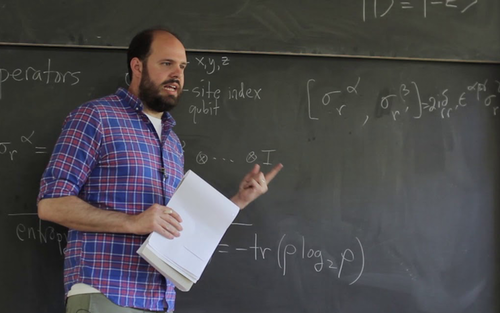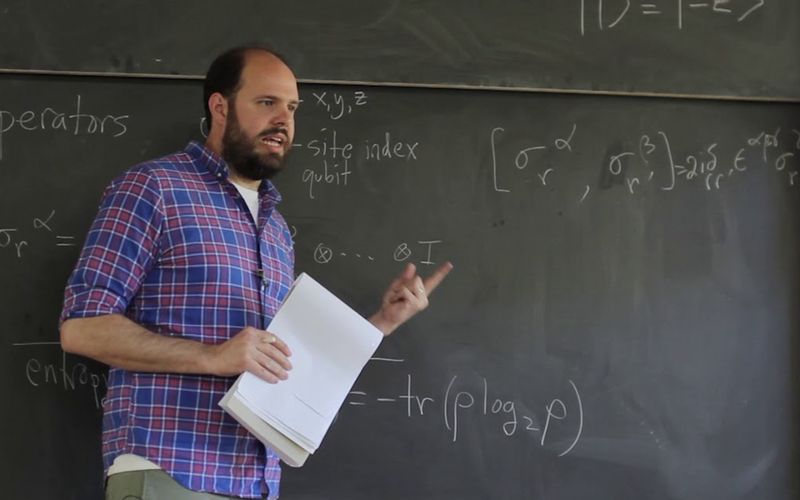Q&A: Searching for the Quantumness of Gravity
Brian Swingle’s first passion was condensed-matter physics. As a graduate student, he performed calculations to uncover and understand new quantum phases of matter, such as topological insulators and spin liquids. But then Swingle signed up for a string theory class. There he realized that the condensed-matter tools he was developing could be used to answer questions in quantum gravity, the theory that could reconcile Einstein’s general theory of relativity with quantum mechanics. The realization led him to dramatically broaden the scope of his research. Today, Swingle heads a research group at the University of Maryland, where he studies condensed-matter problems and seeks to develop a quantum picture of gravity. In an interview with Physics, Swingle explained his love of quantum gravity, why blue-sky funding is particularly important for researchers in this field, and how spacetime might arise from interactions among entangled qubits.
–Matteo Rini
Matteo Rini is the Deputy Editor of Physics.
What about quantum gravity excites you?
In my opinion, quantum gravity tackles one of the most fundamental questions of physics: what is spacetime? In tackling this question, I helped unearth surprising connections between quantum gravity, many-body physics, and quantum information. These connections truly fascinate me.
Can you elaborate on how your condensed-matter physics work led you to quantum gravity?
To model quantum effects in matter, like entanglement, I use so-called tensor networks—mathematical tools that describe patterns of quantum correlations among the states of a large number of interacting particles. My breakthrough—and my interest in quantum gravity— came when I realized that these tensor-network tools might also be applied to describe the physics of gravity.
How so?
The connection with gravity is possible thanks to an important theoretical result obtained about 20 years ago by string physicist Juan Maldacena. He proposed the so-called AdS/CFT (anti de Sitter/conformal field theory) correspondence, which states that for every quantum system with gravity there exists an exactly equivalent system without gravity. This result means that researchers could potentially study a universe with gravity by modeling a simpler, gravityless universe. One promising gravityless quantum system for such studies is an ensemble of quantum particles with carefully tailored interactions—a system very similar to the condensed-matter ones I describe using tensor networks. I am exploring this possibility with others via a multidisciplinary collaboration called “It from Qubit.”
What does “It from Qubit” mean?
The collaboration name is a play on the late Princeton physicist John Wheeler’s phrase “it from bit,” which he used to epitomize the idea that every physical quantity—every “it” in the universe—derives its significance from binary bits of information. His idea was almost correct, but it didn’t consider the full quantum nature of information, hence the qubits. “It from Qubit” brings together quantum information scientists and high-energy physicists, two communities that normally don’t communicate with each other. Together, we develop a new language and new tools to explore the links between quantum information and the physical theories that describe our Universe. One idea developing from the collaboration is that spacetime could emerge from entanglement.
Could you explain this idea further?
The idea is that gravity could emerge from interacting qubits much like a phase of matter can emerge from interacting electrons. We don’t yet have a clear idea of what these qubits could be. But several independent results hint at a similar conclusion: many-body correlations among elementary quantum mechanical objects could lead to the same geometry of spacetime as the one on which general theory of relativity is based.
What factors have helped you make progress in this research area?
Long-term, blue-sky funding from “It from Qubit” has been essential. It’s not the kind of research where funders get fast returns on their dollars so it can be hard to get individual grants. Teaching has also been extremely valuable—questions from young people approaching these problems for the first time bring me a fresh perspective. What’s more, the need to convey my ideas to others has a powerful clarifying effect.
What “big goal” would you like to achieve
I would like to bring quantum gravity theories to the point that they can be tested in experiments.
What kind of experiments?
Cold atoms are an exceptional platform to engineer and control quantum states. They could be used to build networks of fermions that interact with each other in a specific way, realizing the so-called Sachdev-Ye-Kitaev model. As a version of AdS/CFT, this system would be equivalent to a universe with quantum gravity. There are no conceptual barriers for these experiments, but they pose serious engineering challenges. Still, I am confident that researchers will be carrying out these experiments within a decade.
Know a physicist with a knack for explaining their research to others? Write to physics@aps.org. All interviews are edited for brevity and clarity.





